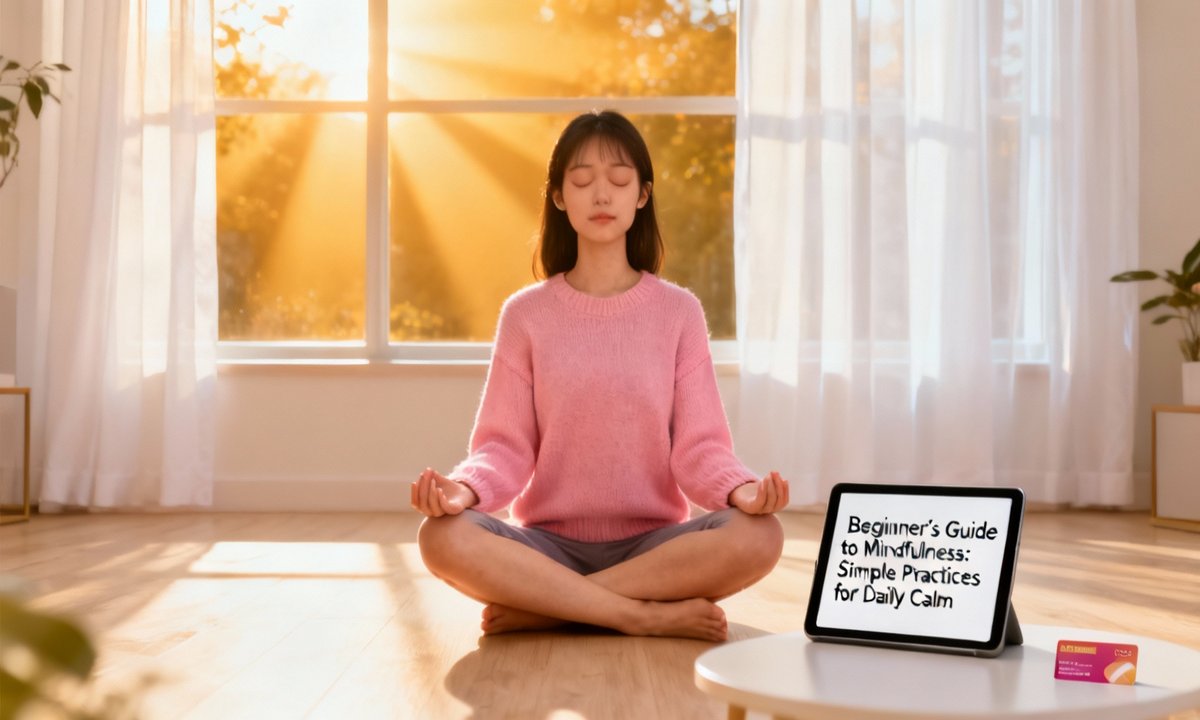Mindfulness for beginners offers a clear path to daily calm, enhanced focus, and reduced stress. No special abilities are required, just a willingness to explore. With techniques supported by science, even a few minutes each day can create a noticeable change. This guide is crafted for anyone seeking to relieve stress, boost overall well-being, and discover ease in a busy modern world.
Embracing Mindfulness: Your Path to Daily Calm
What is Mindfulness?
Mindfulness is about paying close attention to the present moment, free from judgment. It involves noticing your thoughts, emotions, and physical sensations. When your mind drifts, you gently guide your focus back to the present. This awareness, rooted in ancient meditation and modern science, is simple to practice anywhere, at any time. Source: Mayo Clinic.
Why Cultivate Mindfulness?
Integrating mindfulness into your daily routine offers many benefits. Regular mindfulness meditation and simple techniques can significantly reduce stress and ease symptoms of anxiety. It also helps improve emotional resilience. Even brief sessions, as short as five or ten minutes, are proven to help you stay grounded and present in your day-to-day life. Explore these insights from McLean Hospital and Harvard Health.
Simple Practices for Everyday Mindfulness
Getting Started with Mindfulness Exercises
Ready to begin your journey? These mindfulness exercises are approachable and can easily fit into any schedule. They provide excellent ways to introduce calm and focus into your day.
Two-Minute Mindful Breathing
Sit comfortably and direct your attention to your breath. Observe the sensation as air gently flows in and out of your body. If your mind begins to wander, simply bring your focus back to your breath. Try this for two minutes as a quick and effective stress relief practice. Learn more about mindful breathing.
Body Scan Meditation
Lie down or sit with your feet firmly planted. Slowly guide your attention through each part of your body. Notice any sensations, such as warmth, tension, or a gentle tingling, without judgment. This practice brings awareness to your entire physical self and is wonderful for relaxation. Discover body scan techniques.
Three Mindful Breaths
Pause whenever you feel the need. Inhale deeply, truly noticing the feeling of the breath, then exhale slowly. Repeat this for three breaths, concentrating on each sensation. This is a compact mindfulness exercise that you can use in any moment throughout your busy day. Find detailed steps here.
Mindful Walking
As you walk, consciously slow your pace. Tune into every step, feeling the ground beneath your feet. Also, take notice of your immediate surroundings. Even a short walk in silence, perhaps just around your home, can help anchor you firmly in the present moment. Practice mindful walking today.
Mindful Observation
Choose an ordinary object nearby, such as a leaf or a pen. Take time to slow down and explore it using all your senses. Observe its colors, textures, and perhaps even any subtle sounds. This simple mindfulness practice helps build a deeper connection between your senses and the present moment. More on mindful observation.
Integrating Mindfulness into Your Routine
Weaving Mindfulness into Daily Life
It is surprisingly easy to weave mindfulness into your everyday activities. Tasks like brushing your teeth, enjoying a meal, or even showering can become valuable opportunities for mindful awareness. The key is to bring your full attention to the process. Notice physical sensations, thoughts, or sounds, and gently redirect your focus back if your mind begins to drift. See how to bring mindfulness to any routine.
Cultivating a Supportive Environment
A calm and organized space can significantly support your mindfulness journey. Consider simplifying your environment to reduce potential distractions, making regular practice easier. If your surroundings feel cluttered, begin with small steps to tidy up. This habit not only enhances your mental clarity but also fosters a growing sense of peace over time. For inspiring ideas, check out essential storage solutions for every room.
Minimalism and Focused Living
Adopting a minimalist approach at home often translates to fewer distractions for your mind. Dedicating a quiet corner or keeping only what you truly need nearby can make mindfulness for beginners much more inviting and accessible. Embrace simplicity with clever gadgets that aid your focus, drawing inspiration from essential gadgets that simplify your life.
Strategies for Mindfulness Success
Practical Tips for Your Journey
Begin with short, consistent sessions; just two to five minutes is often enough to start. Gradually build up your practice as you feel comfortable. Try to practice at regular times, perhaps after waking up, during your lunch break, or before bedtime. Anchor mindfulness to existing routines, like a mindful sip of morning coffee or a few mindful breaths before meetings. Forgive yourself if your mind wanders, and gently bring your attention back. Explore free guided mindfulness exercises and resources online; The Free Mindfulness Project is an excellent starting point.
Navigating Common Hurdles
If you struggle with a lack of time, try embedding short practices into small gaps in your day. This could be at red lights or while waiting for your coffee. A restless mind is completely normal for beginners. The key is gently returning your focus, again and again, which builds resilience. Avoid impatience or judging your progress; mindfulness is a skill that strengthens with steady practice over time.
Finding Trustworthy Guidance
Many reputable organizations in the U.S. offer robust online guides for beginner mindfulness. These include the Mayo Clinic, Harvard Health, and McLean Hospital. Additionally, community centers, healthcare providers, and meditation groups often feature supportive beginner classes. Apps and websites like Free Mindfulness provide quality resources at no cost to help you get started.
The Profound Benefits of Daily Practice
Transformative Impacts of Mindfulness
Practicing daily calm through mindfulness delivers tangible, research-supported benefits that can truly transform your life.
Regular mindfulness exercises are known to significantly reduce stress and anxiety by lowering the body’s physical stress responses. This helps create a sense of inner peace and composure even amidst life’s challenges.
Mindfulness also fosters greater emotional balance, helping you navigate your feelings more effectively and making difficult moments feel less overwhelming. Furthermore, consistent practice trains your attention, leading to sharper concentration and a potential boost in productivity. Finally, it enhances improved self-awareness, connecting you more deeply to your thoughts and reactions, which nurtures better decision-making in all aspects of your life.
Your Mindfulness Questions Answered
Frequently Asked Questions (FAQs)
How Long Should You Practice Mindfulness?
Begin with two to five minutes daily. As you become more comfortable, you can gradually extend this to ten or fifteen minutes. For beginners, consistency is often more impactful than the duration of each session. Even a brief daily practice can yield noticeable benefits over time.
Can Mindfulness Ease Anxiety?
Yes, mindfulness is widely supported by research as an effective tool for managing stress and anxiety. By focusing on the present moment, you can often calm anxious thoughts and reduce the overall impact of stress on your system. If you experience chronic anxiety, speaking with a healthcare provider is recommended to create a supportive, personalized plan.
What if Your Mind Wanders?
Wandering thoughts are a perfectly normal part of mindfulness practice; everyone experiences them. The core essence of mindfulness is simply noticing when your mind has drifted and then gently, without any self-criticism, bringing your focus back to the present moment. With consistent practice, this skill of returning attention will naturally improve.
Do You Need Special Equipment for Mindfulness?
No special tools or equipment are required for mindfulness meditation or exercises. All you truly need is a few minutes of your time, a comfortable space where you won’t be disturbed, and an open, receptive mind. Simple adjustments, like creating a tidy corner, can certainly make your practice easier and more inviting. For creative ideas, explore minimalist home solutions.
How to Maintain Consistency?
To stay consistent, try anchoring mindfulness to your everyday habits. Pair it with your morning coffee, your daily walk, or even your commute. Short, gentle reminders, cultivating a supportive environment, and practicing self-kindness are all key elements. For more tips and routines on optimizing your living space for ease and calm, consider our guide to essential storage solutions.
Embark on Your Mindfulness Journey Today!
Begin your journey with just one brief practice. Try a few mindful breaths, a moment of mindful observation, or a two-minute body scan. You don’t need to strive for perfection or dedicate hours of your valuable time. With patience and consistent effort, a sense of daily calm is well within reach for everyone.
For more ways to simplify and support your lifestyle, explore essential smart gadgets for a minimalist home. Consider signing up for our weekly mindfulness and lifestyle tips to further support your routine. Remember, taking regular breaks from screens is also a vital part of mindful living; try logging off and practicing presence today.



